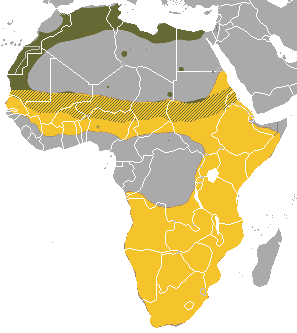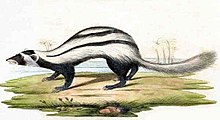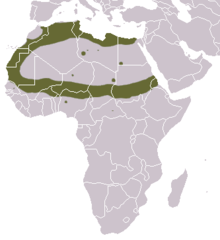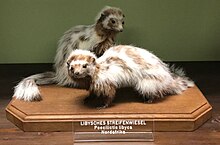
The striped polecat, also called the African polecat, zoril, zorille, zorilla, Cape polecat, and African skunk, is a member of the family Mustelidae that resembles a skunk. The name "zorilla" comes from the word "zorro", which in Spanish means "fox". It lives predominantly in dry and arid climates, such as the savannahs and open country of Central, Southern, and sub-Saharan Africa, excluding the Congo basin and the more coastal areas of West Africa.

The rhim gazelle or rhim from Arab Language غزال الريم in Arabic(Gazella leptoceros), also known as the slender-horned gazelle, African sand gazelle or Loder's gazelle, is a pale-coated gazelle with long slender horns and well adapted to desert life. It is considered an endangered species because fewer than 2500 are left in the wild. They are found in Algeria, Egypt, Tunisia and Libya, and possibly Chad, Mali, Niger, and Sudan.

The steppe polecat, also known as the white or masked polecat, is a species of mustelid native to Central and Eastern Europe and Central Asia. It is listed as Least Concern on the IUCN Red List because of its wide distribution, occurrence in a number of protected areas, and tolerance to some degree of habitat modification. It is generally of a very light yellowish colour, with dark limbs and a dark mask across the face. Compared to its relative, the European polecat, the steppe polecat is larger in size and has a more powerfully built skull.

The greater Egyptian gerbil is a small rodent in the family Muridae. It is native to northern Africa where it inhabits sandy deserts, semi-arid areas and oases. It is a common species, and the International Union for Conservation of Nature has rated its conservation status as being of "least concern".

Ictonyx is a genus in the family Mustelidae (weasels). It contains two species:

The marbled polecat is a small mammal belonging to the monotypic genus Vormela within the mustelid subfamily Ictonychinae. Vormela is from the German word Würmlein, which means "little worm". The specific name peregusna comes from perehuznya (перегузня), which is Ukrainian for "polecat". Marbled polecats are generally found in the drier areas and grasslands of southeastern Europe to western China. Like other members of the Ictonychinae, it can emit a strong-smelling secretion from anal sacs under the tail when threatened.

The African striped weasel, the lone member of the genus Poecilogale, is a small, black and white weasel native to sub-Saharan Africa.

The lesser jerboa is a small rodent of Africa and the Middle East. Its diet consists mainly of seeds and grasses.

The North African gerbil is a species of rodent in the family Muridae. It is found in North Africa where its natural habitats are arable land and rocky areas of the Maghreb, and hot Saharan deserts.

The Libyan jird is a species of rodent in the family Muridae. It is found in Mauritania, Morocco, Algeria, Tunisia, Libya, Egypt, Jordan, Syria, Saudi Arabia, Iran, Iraq, Afghanistan, Turkmenistan, Uzbekistan, Kazakhstan and Western China. Its natural habitats are subtropical or tropical dry shrubland, intermittent saline lakes, hot deserts, and rural gardens.

The forest shrew is a species of shrew in the mouse shrew family, Soricidae. It is found in Lesotho, South Africa, and Eswatini. Its natural habitats include temperate forests, dry savanna, Mediterranean-type shrubby vegetation, and temperate grassland. The term "forest shrews" in the plural is sometimes confusingly used to collectively refer to a different genus, Sylvisorex.














